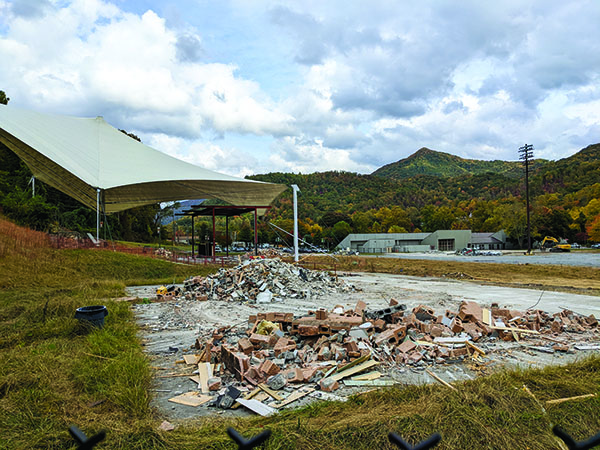By ROBERT JUMPER
One Feather Editor
Come mothers and fathers
Throughout the land
And don’t criticize
What you can’t understand
Your sons and your daughters
Are beyond your command
Your old road is rapidly agin’
Please get out of the new one
If you can’t lend your hand
For the times they are a-changin’ – Bob Dylan, 1964
With the demolition of the Cherokee Indian Fairgrounds buildings, it is hard to not feel that it marks an ending. It is fitting that the trees are going into hibernation, a type of death for the forests until the warm weather next year revives them.

A photo, taken on the afternoon of Thursday, Oct. 13, shows the current demolition going on at the Cherokee Indian Fairgrounds. (ROBERT JUMPER/One Feather photo)
I was walking by the Cherokee Historical Association offices today (Thursday, Oct. 14) and saw a Monarch butterfly, arguably one of the most beautiful creatures on earth, perched on the art bear in front of the building. The butterfly is another creature that exemplifies that life-death-resurrection cycle that we see in many things on this earth. Ugly little larvae become ugly little cocoons. Then what pops out of the cocoon? Something so beautiful, so intricate, so breathtaking that all thought of that old ugly larvae is gone. In fact, unless you weren’t told and shown in school what the process is to make that butterfly, you would never believe that gorgeous bug could come from that unattractive little worm. But it does.
Sometimes we don’t embrace change because we are comfortable with whatever we have. The struggle to upgrade or improve the ceremonial grounds has been going on for decades. We have been comfortable with what we have. Going from larvae to butterfly takes sacrifice, a complete destruction to birth a “better” being. In the case of the Fairgrounds, resistance came because of the financial investment and loss of tradition needed to renovate. Proposal after proposal would get tabled because of the sacrifice of time, place, and cash needed to make the transformation.
We have done it other places. The “old elementary school” and the “old high school” sites have sat dormant for many years with no permanent use, just the occasional events and storage. Let’s say that they have stayed in the cocoon phase of their transition. Now, it seems, there is a more substantial use for the old high school site, in that it has been mentioned that it is at least a semi-permanent grow site for the Tribe’s new cannabis venture. The times they are a changin’.
Bob Dylan wrote his song about progress 58 years ago. I am finally old enough to get it. When your personal life race is closer to the end than the beginning, you realize that having things your way isn’t always the right way. That what will be useful to you may not be as useful to the younger masses. As time goes on, I expect I won’t have need or desire for many things that I hold dear now.
The staff and I were talking this morning about traditions and what they actually are. Are they things we do over and over again until we don’t remember why we do them, we just sense that we need to continue to do them? My example was the practice of sporting tattoos. I talked with a guy that had an impressive bit of artwork on his forearm and I asked him about his “tat”. He said he got tattooed because it was a tradition of his people from before the 1600s. I said that is interesting, since his tattoo paid homage to Led Zeppelin, a rock band that definitely wasn’t a band back in the 1600s. I get what he was saying, but I think we also overuse and abuse the word “tradition”.
On the other hand, it sure is hard to let go. A sense of place is to many one of the important feelings. We connect memories, good and bad, to places. When the old Cherokee High School was up for demolition, several in the community expressed deep emotion for the loss of that place that held so many memories of love and kinship. Most of us knew it was irrational to leave a building and property dormant and decaying because of our emotional connection. Some may have had such an emotional connection that they would have left it standing…or falling apart.
If things like buildings could stay in perfect condition from decade to decade, we might be able to hold on to them. If those buildings would remain functional for the purposes of an ever-evolving culture, there would be no need to replace them.
Interesting anecdote about buildings: we commonly call the building where people attend religious services a “church”. But technically, the church consists of the people who gather in the building who are of like faith. Over the years, people used the term “going to church” and they meant that they were going to a religious meeting, not to a specific building designed for their meeting. Why did they call those places churches? Because of tradition. Those congregating people had to call their meeting place something and since they called their gathering “church” it seemed traditional to start naming their new meeting buildings church because it had been stuck in their gatherings over the years.
Likewise, schools are not buildings. They are the people that go to those buildings to educate and be educated. What makes a place important are the people who use them. Those great memories of the first date at the Fair, the last story told by a revered elder, the most harrowing ride on the Tilt-A-Whirl, all those memories are about people, but they are forever attached to a place. But just because the place goes away or changes, doesn’t mean you have to lose that memory. It is still there in that photo album or tucked away as a precious moment in your mind. Physical reminders will go away or possibly become weathered with age, but we still cherish and hold onto the memory.
So, change is inevitable. And our older sensibilities may not match those of our younger counterparts. At younger ages than most in recent history, young(er) people are making decisions about big issues, including land use. Our tendency is to hang on to what we feel is traditional, especially if we had a hand in creating it. Many of us scratch our heads at the new concepts put forth by a younger generation, because their ideas do not belong to our traditions, and it seems to us that they are a generation out of control. The truth is that they are or soon will be in control. But as Dylan prophesied in his song, we can choose to be a roadblock to change or we can get on board and find ways to help.
And as certain things come to an end, and are replaced by the new, we may find that there is beauty in the transformation. Sometimes it is better not to look back.





